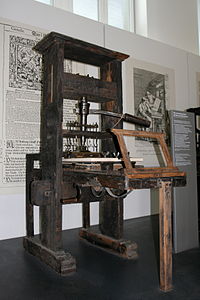 |
| Printing press from 1811, Wikipedia |
By the time a book is in galley form it's gone through a number of edits by the author and then on to the substantive edit, which in my case is done by freelance editors. I've had a different editor for each of my three novels. I love getting the galley for several reasons: it means the book is close to finished, I still have a chance to make changes (and you'd be surprised what I find that needs changed at the last minute), and I enjoy seeing the design used on the pages or the
Miriam-Webster defines it as:
a : an oblong tray to hold especially a single column of set type
b : a proof of typeset matter especially in a single column before being made into pages
 |
| Movable type on a composing stick, Wikipedia |
Wikipedia states that, "Galley proofs are so named because in the days of hand-set type,
the printer would set the page into galleys, the metal trays into which
type was laid and tightened into place. These would be used to print a
limited number of copies for editing mark-up. The printer would then receive the edits, re-arrange the type, and print the final copy." Here's their article about Galleys.
I found a wonderful article on The History of Printing that you are sure to find fascinating. We own much to Johann Gutenberg (1400? - 1468). Within this article I was surprised to see the name John Baskerville (1706 - 1775). Could this be where Doyle got the name for his famous novel, The Hound of the Baskervilles? See what research leads us to? There is a long list of links that will lead you to just about anything and everything you would want to know regarding the history of printing. Enjoy. Have you learned something about galleys or the printing world while working in the book publishing industry or elsewhere?
























0 comments:
Post a Comment